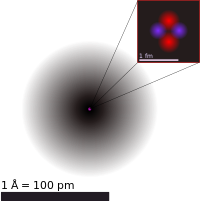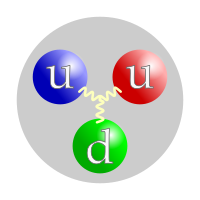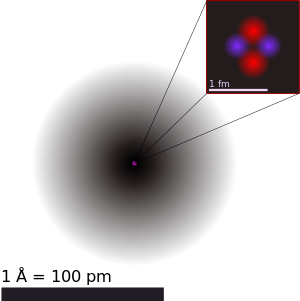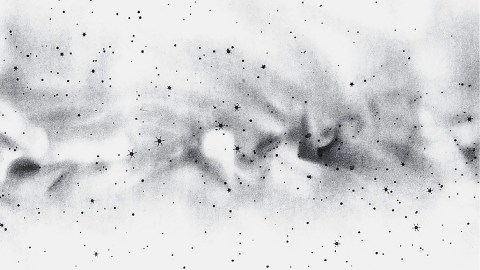Particle
A particle is a tiny bit of matter that makes up everything in the universe. In particle physics, an elementary particle is a particle which cannot be split up into smaller pieces.
There are many different types of particles, with different particle sizes and properties.
Macroscopic particles are particles that are larger than atoms or molecules. They have volume and shape. Powder and dust are some examples of macroscopic particles. Nanoparticles are an intermediate size, being a very fine powder but much larger than atoms.
Atoms and molecules are called microscopic particles.
Subatomic particles are particles that are smaller than atoms. The proton, the neutron, and the electron are subatomic particles. These are the particles which make atoms. The proton has a positive charge (a + charge). The neutron has a neutral charge. The electron has a negative charge (a - charge), and it is the smallest of these three particles. In atoms, there is a small nucleus in the center, which is where the protons and neutrons are, and electrons orbit the nucleus.
Protons and neutrons are made up of quarks. Quarks are subatomic particles, but they are also elementary particles because we do not know if they are made up of even smaller particles. There are six different types of quarks. These are the up quark, the down quark, the strange quark, the charm quark, the bottom quark, and the top quark. A neutron is made of two down quarks and one up quark. The proton is made up of two up quarks and one down quark.
Theoretical particle
Theoretical particles are particles that have been assumed or predicted to exist by scientists, but have not been proven in any experiment. Some, like the tachyon, probably don't exist, since they violate several laws of physics. However, many are still believed to exist. All supersymmetric particles (such as a sfermion) are theoretical. Supersymmetrical particles are often abbreviated with an "s" in front of the particle name, like a sfermion. Particles found in antimatter are not theoretical particles because they have been found in numerous experiments.
A list of theoretical particles
Supersymmetrical Particles
Particles that disobey laws of physics
Other hypothetical particles
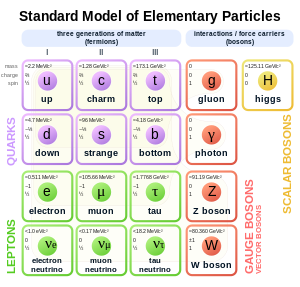 |
| Standard Model of elementary particles. 1 GeV/c2 = 1.783x10-27 kg. 1 MeV/c2 = 1.783x10-30 kg. |
Elementary particle
An elementary particle can be one of two groups: a fermion or a boson. Fermions are the building blocks of matter and have mass, while bosons behave as force carriers for fermion interactions and some of them have no mass.[1] The Standard Model is the most accepted way to explain how particles behave, and the forces that affect them. According to this model, the elementary particles are further grouped into quarks, leptons, and gauge bosons, with the Higgs boson having a special status as a non-gauge boson.
Of the particles that make up an atom, only the electron is an elementary particle. Protons and neutrons are each made of 3 quarks, which makes them composite particles, particles that are made of other particles. The quarks are bound together by the gluons. The nucleus has boson pion fields responsible for the strong nuclear force binding protons and neutrons against the electrostatic repulsion between protons. Such virtual pions are composed of quark antiquark pairs again held together by gluons.
There are three basic properties that describe an elementary particle: ’mass’, ’charge’, and ’spin’. Each property is assigned a number value. For mass and charge the number can be zero. For example, a photon has zero mass and a neutrino has zero charge. These properties always stay the same for an elementary particle.
- Mass: A particle has mass if it takes energy to increase its speed, or to accelerate it. The table to the right gives the mass of each elementary particle. The values are given in MeV/c2s (that is pronounced megaelectronvolts over "c" squared), that is in units of energy over the speed of light squared. This comes from special relativity, which tells us that energy equals mass times the square of the speed of light. All particles with mass-produce gravity. All particles are affected by gravity, even particles with no mass like the photon (see general relativity).
- Electric charge: Particles may have positive charge, or negative, or none. If one particle has a negative charge, and another particle has a positive charge, the two particles are attracted to each other. If the two particles both have negative charge, or both have positive charge, the two particles are pushed apart. At short distances, this force is much stronger than the force of gravity which pulls all particles together. An electron has charge -1. A proton has charge +1. A neutron has an average charge 0. Normal quarks have charge of ⅔ or -⅓.
- Spin: The angular momentum or constant turning of a particle has a particular value, called its spin number. Spin for elementary particles is one or ½. The spin property of particles only denotes the presence of angular momentum. In reality, the particles do not spin.
Mass and charge are properties we see in everyday life, because gravity and electricity affect things that humans see and touch. But spin affects only the world of subatomic particles, so it cannot be directly observed.
Fermions
Fermions (named after the scientist Enrico Fermi) have a spin number of ½, and are either quarks or leptons. There are 12 different types of fermions (not including antimatter). Each type is called a "flavor". The flavors are:
- Quarks: up, down, charm, strange, top, bottom. Quarks come in three pairs, called "generations". The 1st generation (up and down) is the lightest and the third (top and bottom) is the heaviest. One member of each pair (up, charm and top) has a charge of ⅔. The other member (down, strange and bottom) has charge -⅓.
- Leptons: electron, muon, tau, electron neutrino, muon neutrino, tau neutrino. The neutrinos have charge 0, hence the neutr- prefix. The other leptons have charge -1. Each neutrino is named after its corresponding original lepton: the electron, muon, and tauon.
Six of the 12 fermions are thought to last forever: up and down quarks, the electron, and the three kinds of neutrinos (which constantly switch flavor). The other fermions decay. That is, they break down into other particles a fraction of a second after they are created. Fermi-Dirac statistics is a theory that describes how collections of fermions behave.
Bosons
Bosons, named after the Indian physicist Satyendra Nath Bose, have spin 1. Although most bosons are made of more than one particle, there are two kinds of elementary bosons:
- Gauge bosons: gluons, W+ and W- bosons, Z0 bosons, and photons. These bosons carry 3 of the 4 fundamental forces, and have a spin number of 1;
- Gluon: Gluons are massless and chargeless particles, and they are the carriers of the strong force interaction. They, along with quarks, join together to make composite particles called hadrons, which include protons and neutrons.
- W and Z bosons: W and Z bosons are particles that carry the weak force. The W boson has a matter particle (W+) and an antimatter particle (W-), whereas the Z boson is its own anti-particle. The W boson is produced in beta decay, but almost immediately turns into a neutrino and an electron. The W and Z bosons were both discovered in 1983.
- Photon: Photons are massless and chargeless particles that carry the electromagnetic force. Photons can have a certain frequency that determines what electromagnetic radiation they are. Like all other massless particles they travel at the speed of light (300,000 km/s).
- Higgs boson: Physicists believe that massive particles have mass (that is, they are not pure bundles of energy like photons) because of the Higgs interaction.
The photon and the gluons have no charge, and are the only elementary particles that have a mass of 0 for certain. The photon is the only boson that does not decay. Bose-Einstein statistics is a theory that describes how collections of bosons behave. Unlike fermions, it is possible to have more than one boson in the same space at the same time.
The Standard Model includes all of the elementary particles described above. All these particles have been observed in the laboratory.
The Standard Model does not talk about gravity. If gravity works like the three other fundamental forces, then gravity is carried by the hypothetical boson called the graviton. The graviton has yet to be found, so it is not included in the table above.
The first fermion to be discovered, and the one we know the most about, is the electron. The first boson to be discovered, and also the one we know the most about, is the photon. The theory that most accurately explains how the electron, photon, electromagnetism, and electromagnetic radiation all work together is called quantum electrodynamics.
 |
| click to enlarge |
Elementary particles
From Simple English Wikipedia, the free encyclopedia
A
Axion
B
Boson
E
Electron
F
Fermion
G
Gauge boson
Gluon
Gravitino
H
Higgs boson
L
Lepton
M
Muon
N
Neutrino
P
Photon
Positron
S
Scalar boson
T
Tau lepton
Tau neutrino
Theoretical particle
W
W and Z bosons
Τ
Template:Leptons
Template:Physics particle
 |
| click here to enlarge |
 |
| click to enlarge here |
 |
| click here to enlarge |
Composite particle
Composite particles are subatomic particles that are made of more than one quark. Simple particles like protons are actually composites of multiple quarks. Protons are known as baryons, which means that they are made of exactly three quarks. Baryons are in a family called Hadrons, which simply means that they are made of quarks. The only other subcategory of Hadrons is Mesons, which are made of one quark and one antiquark.
Since they are made of quarks, composite particles are not so much hard balls, but rather like clouds that contain these quarks. Depending on the energy contained by the quarks, the quarks of a proton vibrate, and this gives a proton a size larger than the actual size of the three quarks combined.
* * * * * * * * *
 |
| click here to enlarge |
List of particles
This is a list of known and hypothesized particles.
Elementary Particles
Elementary particles are particles with no measurable internal structure; that is, it is unknown whether they are composed of other particles.[1] They are the fundamental objects of quantum field theory. Many families and sub-families of elementary particles exist. Elementary particles are classified according to their spin. Fermions have half-integer spin while bosons have integer spin. All the particles of the Standard Model have been experimentally observed, recently including the Higgs boson in 2012.[2][3] Many other hypothetical elementary particles, such as the graviton, have been proposed, but not observed experimentally.
Fermions
Fermions are one of the two fundamental classes of particles, the other being bosons. Fermion particles are described by Fermi–Dirac statistics and have quantum numbers described by the Pauli exclusion principle. They include the quarks and leptons, as well as any composite particles consisting of an odd number of these, such as all baryons and many atoms and nuclei.
Fermions have half-integer spin; for all known elementary fermions this is 1⁄2. All known fermions, except neutrinos, are also Dirac fermions; that is, each known fermion has its own distinct antiparticle. It is not known whether the neutrino is a Dirac fermion or a Majorana fermion.[4] Fermions are the basic building blocks of all matter. They are classified according to whether they interact via the strong interaction or not. In the Standard Model, there are 12 types of elementary fermions: six quarks and six leptons.
Quarks
Quarks are the fundamental constituents of hadrons and interact via the strong force. Quarks are the only known carriers of fractional charge, but because they combine in groups of three (baryons) or in pairs of one quark and one antiquark (mesons), only integer charge is observed in nature. Their respective antiparticles are the antiquarks, which are identical except that they carry the opposite electric charge (for example the up quark carries charge +2⁄3, while the up antiquark carries charge −2⁄3), color charge, and baryon number. There are six flavors of quarks; the three positively charged quarks are called "up-type quarks" while the three negatively charged quarks are called "down-type quarks".
| Generation | Name | Symbol | Antiparticle | Spin | Charge (e) | Mass (MeV/c2) [5] |
|---|---|---|---|---|---|---|
| 1 | up | u | u | 1⁄2 | +2⁄3 | 2.2+0.6 −0.4 |
| down | d | d | 1⁄2 | −1⁄3 | 4.6+0.5 −0.4 | |
| 2 | charm | c | c | 1⁄2 | +2⁄3 | 1,280±30 |
| strange | s | s | 1⁄2 | −1⁄3 | 96+8 −4 | |
| 3 | top | t | t | 1⁄2 | +2⁄3 | 173,100±600 |
| bottom | b | b | 1⁄2 | −1⁄3 | 4,180+40 −30 |
Leptons
Leptons do not interact via the strong interaction. Their respective antiparticles are the antileptons, which are identical, except that they carry the opposite electric charge and lepton number. The antiparticle of an electron is an antielectron, which is almost always called a "positron" for historical reasons. There are six leptons in total; the three charged leptons are called "electron-like leptons", while the neutral leptons are called "neutrinos". Neutrinos are known to oscillate, so that neutrinos of definite flavor do not have definite mass, rather they exist in a superposition of mass eigenstates. The hypothetical heavy right-handed neutrino, called a "sterile neutrino", has been left off the list.
| Generation | Name | Symbol | Antiparticle | Spin | Charge (e) | Mass (MeV/c2) [5] |
|---|---|---|---|---|---|---|
| 1 | Electron | e− | e+ | 1⁄2 | −1 | 0.511[note 1] |
| Electron neutrino | ν e | ν e | 1⁄2 | 0 | < 0.0000022 | |
| 2 | Muon | μ− | μ+ | 1⁄2 | −1 | 105.7[note 2] |
| Muon neutrino | ν μ | ν μ | 1⁄2 | 0 | < 0.170 | |
| 3 | Tau | τ− | τ+ | 1⁄2 | −1 | 1,776.86±0.12 |
| Tau neutrino | ν τ | ν τ | 1⁄2 | 0 | < 15.5 |
Bosons
Bosons are one of the two fundamental particles having integral spinclasses of particles, the other being fermions. Bosons are characterized by Bose–Einstein statistics and all have integer spins. Bosons may be either elementary, like photons and gluons, or composite, like mesons.
According to the Standard Model, the elementary bosons are:
| Name | Symbol | Antiparticle | Spin | Charge (e) | Mass (GeV/c2) [5] | Interaction mediated | Observed |
|---|---|---|---|---|---|---|---|
| Photon | γ | Self | 1 | 0 | 0 | Electromagnetism | Yes |
| W boson | W− | W+ | 1 | −1 | 80.385±0.015 | Weak interaction | Yes |
| Z boson | Z | Self | 1 | 0 | 91.1875±0.0021 | Weak interaction | Yes |
| Gluon | g | Self | 1 | 0 | 0 | Strong interaction | Yes |
| Higgs boson | H0 | Self | 0 | 0 | 125.09±0.24 | Mass | Yes |
The Higgs boson is postulated by the electroweak theory primarily to explain the origin of particle masses. In a process known as the "Higgs mechanism", the Higgs boson and the other gauge bosons in the Standard Model acquire mass via spontaneous symmetry breaking of the SU(2) gauge symmetry. The Minimal Supersymmetric Standard Model (MSSM) predicts several Higgs bosons. On 4 July 2012, the discovery of a new particle with a mass between 125 and 127 GeV/c2 was announced; physicists suspected that it was the Higgs boson. Since then, the particle has been shown to behave, interact, and decay in many of the ways predicted for Higgs particles by the Standard Model, as well as having even parity and zero spin, two fundamental attributes of a Higgs boson. This also means it is the first elementary scalar particle discovered in nature.
Elementary bosons responsible for the four fundamental forces of nature are called force particles (gauge bosons). Strong interaction is mediated by the gluon, weak interaction is mediated by the W and Z bosons.
Hypothetical particles
Supersymmetric theories predict the existence of more particles, none of which have been confirmed experimentally.
| Name | Symbol | Antiparticle | Spin | Charge (e) | Mass (GeV/c2) [5] | Interaction mediated | Observed |
|---|---|---|---|---|---|---|---|
| Graviton | G | Self | 2 | 0 | 0 | Gravitation | No |
The graviton is a hypothetical particle that has been included in some extensions to the standard model to mediate the gravitational force. It is in a peculiar category between known and hypothetical particles: As an unobserved particle that is not predicted by, nor required for the Standard Model, it belongs in the table of hypothetical particles, below. But gravitational force itself is a certainty, and expressing that known force in the framework of a quantum field theory requires a boson to mediate it.
| Superpartner | Spin | Notes | superpartner of: |
|---|---|---|---|
| chargino | 1⁄2 | The charginos are superpositions of the superpartners of charged Standard Model bosons: charged Higgs boson and W boson. The MSSM predicts two pairs of charginos. | charged bosons |
| gluino | 1⁄2 | Eight gluons and eight gluinos. | gluon |
| gravitino | 3⁄2 | Predicted by supergravity (SUGRA). The graviton is hypothetical, too – see next table. | graviton |
| Higgsino | 1⁄2 | For supersymmetry there is a need for several Higgs bosons, neutral and charged, according with their superpartners. | Higgs boson |
| neutralino | 1⁄2 | The neutralinos are superpositions of the superpartners of neutral Standard Model bosons: neutral Higgs boson, Z boson and photon. The lightest neutralino is a leading candidate for dark matter. The MSSM predicts four neutralinos. | neutral bosons |
| photino | 1⁄2 | Mixing with zino and neutral Higgsinos for neutralinos. | photon |
| sleptons | 0 | The superpartners of the leptons (electron, muon, tau) and the neutrinos. | leptons |
| sneutrino | 0 | Introduced by many extensions of the Standard Supermodel, and may be needed to explain the LSND results. A special role has the sterile sneutrino, the supersymmetric counterpart of the hypothetical right-handed neutrino, called the "sterile neutrino". | neutrino |
| squarks | 0 | The stop squark (superpartner of the top quark) is thought to have a low mass and is often the subject of experimental searches. | quarks |
| wino, zino | 1⁄2 | The charged wino mixing with the charged Higgsino for charginos, for the zino see line above. | W± and Z0 bosons |
Just as the photon, Z boson and W± bosons are superpositions of the B0, W0, W1, and W2 fields, the photino, zino, and wino± are superpositions of the bino0, wino0, wino1, and wino2. No matter if one uses the original gauginos or this superpositions as a basis, the only predicted physical particles are neutralinos and charginos as a superposition of them together with the Higgsinos.
Other theories predict the existence of additional bosons:
| Name | Spin | Notes |
|---|---|---|
| axion | 0 | A pseudoscalar particle introduced in Peccei–Quinn theory to solve the strong-CP problem. |
| axino | 1⁄2 | Superpartner of the axion. Forms, together with the saxion and axion, a supermultiplet in supersymmetric extensions of Peccei–Quinn theory. |
| branon | ? | Predicted in brane world models. |
| chameleon | 0 | a possible candidate for dark energy and dark matter, and may contribute to cosmic inflation. |
| dilaton | 0 | Predicted in some string theories. |
| dilatino | 1⁄2 | Superpartner of the dilaton. |
| dual graviton | 2 | Has been hypothesized as dual of graviton under electric–magnetic duality in supergravity. |
| graviphoton | 1 | Also known as "gravivector".[6] |
| graviscalar | 0 | Also known as "radion". |
| inflaton | 0 | Unknown force-carrier that is presumed to have the physical cause of cosmological “inflation” – the rapid expansion from 10−35 to 10−34 seconds after the Big Bang. |
| magnetic photon | ? | A. Salam (1966). "Magnetic monopole and two photon theories of C-violation." Physics Letters 22 (5): 683–684. |
| majoron | 0 | Predicted to understand neutrino masses by the seesaw mechanism. |
| majorana fermion | 1⁄2 ; 3⁄2 ?... | gluino, neutralino, or other – is its own antiparticle. |
| saxion | 0 | |
| X17 particle | ? | possible cause of anomalous measurement results near 17 MeV, and possible candidate for dark matter. |
| X and Y bosons | 1 | These leptoquarks are predicted by GUT theories to be heavier equivalents of the W and Z. |
| W' and Z' bosons | 1 |
Mirror particles are predicted by theories that restore parity symmetry.
"Magnetic monopole" is a generic name for particles with non-zero magnetic charge. They are predicted by some GUTs.
"Tachyon" is a generic name for hypothetical particles that travel faster than the speed of light (and so paradoxically experience time in reverse due to inversal of Theory of relativity) and have an imaginary rest mass, they would violate the laws of causality.
Preons were suggested as subparticles of quarks and leptons, but modern collider experiments have all but ruled out their existence.
Kaluza–Klein towers of particles are predicted by some models of extra dimensions. The extra-dimensional momentum is manifested as extra mass in four-dimensional spacetime.
Composite particles
Hadrons
Hadrons are defined as strongly interacting composite particles. Hadrons are either:
- Composite fermions (especially 3 quarks), in which case they are called baryons.
- Composite bosons (especially 2 quarks), in which case they are called mesons.
Quark models, first proposed in 1964 independently by Murray Gell-Mann and George Zweig (who called quarks "aces"), describe the known hadrons as composed of valence quarks and/or antiquarks, tightly bound by the color force, which is mediated by gluons. (The interaction between quarks and gluons is described by the theory of quantum chromodynamics.) A "sea" of virtual quark-antiquark pairs is also present in each hadron.
Baryons
Ordinary baryons (composite fermions) contain three valence quarks or three valence antiquarks each.
- Nucleons are the fermionic constituents of normal atomic nuclei:
- Hyperons, such as the Λ, Σ, Ξ, and Ω particles, which contain one or more strange quarks, are short-lived and heavier than nucleons. Although not normally present in atomic nuclei, they can appear in short-lived hypernuclei.
- A number of charmed and bottom baryons have also been observed.
- Pentaquarks consist of four valence quarks and one valence antiquark.
- Other exotic baryons may also exist.
Mesons
Ordinary mesons are made up of a valence quark and a valence antiquark. Because mesons have spin of 0 or 1 and are not themselves elementary particles, they are "composite" bosons. Examples of mesons include the pion, kaon, and the J/ψ. In quantum hadrodynamics, mesons mediate the residual strong force between nucleons.
At one time or another, positive signatures have been reported for all of the following exotic mesons but their existences have yet to be confirmed.
- A tetraquark consists of two valence quarks and two valence antiquarks;
- A glueball is a bound state of gluons with no valence quarks;
- Hybrid mesons consist of one or more valence quark–antiquark pairs and one or more real gluons.
Atomic nuclei
Atomic nuclei consist of protons and neutrons. Each type of nucleus contains a specific number of protons and a specific number of neutrons, and is called a "nuclide" or "isotope". Nuclear reactions can change one nuclide into another. See table of nuclides for a complete list of isotopes.
Atoms
Atoms are the smallest neutral particles into which matter can be divided by chemical reactions. An atom consists of a small, heavy nucleus surrounded by a relatively large, light cloud of electrons. Each type of atom corresponds to a specific chemical element. To date, 118 elements have been discovered or created.
An atomic nucleus consists of 1 or more protons and 0 or more neutrons. Protons and neutrons are, in turn, made of quarks.
Molecules
Molecules are the smallest particles into which a substance can be divided while maintaining the chemical properties of the substance. Each type of molecule corresponds to a specific chemical substance. A molecule is a composite of two or more atoms. See list of compounds for a list of molecules. Atoms are combined in a fixed proportion to form a molecule. Molecule is one of the most basic units of matter.
Quasiparticles
Quasiparticles are effective particles that exist in many particle systems. The field equations of condensed matter physics are remarkably similar to those of high energy particle physics. As a result, much of the theory of particle physics applies to condensed matter physics as well; in particular, there are a selection of field excitations, called quasi-particles, that can be created and explored. These include:
- Phonons are vibrational modes in a crystal lattice.
- Excitons are bound states of an electron and a hole.
- Plasmons are coherent excitations of a plasma.
- Polaritons are mixtures of photons with other quasi-particles.
- Polarons are moving, charged (quasi-) particles that are surrounded by ions in a material.
- Magnons are coherent excitations of electron spins in a material.
Other
- Accelerons are hypothetical particles postulated to relate neutrino mass to dark energy, and are named for the role they play in the accelerating expansion of the universe
- An anyon is a generalization of fermion and boson in two-dimensional systems like sheets of graphene that obeys braid statistics.
- A plekton is a theoretical kind of particle discussed as a generalization of the braid statistics of the anyon to dimension > 2.
- A WIMP (weakly interacting massive particle) is any one of a number of particles that might explain dark matter (such as the neutralino or the axion).
- A WISP (weakly interacting slender particle) is any one of a number of low mass particles that might explain dark matter.
- A GIMP (gravitationally interacting massive particle) is a particle which provides an alternative explanation of dark matter, instead of the aforementioned WIMP.
- The pomeron, used to explain the elastic scattering of hadrons and the location of Regge poles in Regge theory.
- The skyrmion, a topological solution of the pion field, used to model the low-energy properties of the nucleon, such as the axial vector current coupling and the mass.
- A Goldstone boson is a massless excitation of a field that has been spontaneously broken. The pions are quasi-goldstone bosons (quasi- because they are not exactly massless) of the broken chiral isospin symmetry of quantum chromodynamics.
- A goldstino is a goldstone fermion produced by the spontaneous breaking of supersymmetry.
- An instanton is a field configuration which is a local minimum of the Euclidean action. Instantons are used in nonperturbative calculations of tunneling rates.
- A dyon is a hypothetical particle with both electric and magnetic charges.
- A geon is an electromagnetic or gravitational wave which is held together in a confined region by the gravitational attraction of its own field of energy.
- An inflaton is the generic name for an unidentified scalar particle responsible for the cosmic inflation.
- A spurion is the name given to a "particle" inserted mathematically into an isospin-violating decay in order to analyze it as though it conserved isospin.
- What is called "true muonium", a bound state of a muon and an antimuon, is a theoretical exotic atom which has never been observed.
- A dislon is a localized collective excitation of a crystal dislocation around the static displacement.
Classification by speed
- A tardyon or bradyon travels slower than light and has a non-zero, real rest mass.
- A luxon travels at the speed of light and has no rest mass.
- A tachyon (mentioned above) is a hypothetical particle that travels faster than the speed of light and has an imaginary rest mass.
See also
- List of baryons
- List of compounds for a list of molecules
- List of fictional elements, materials, isotopes and atomic particles
- List of mesons
- Particle zoo
- Ion
- Periodic table for an overview of atoms
- Standard Model for the current consensus theory of these particles
- Table of nuclides
- Timeline of particl


